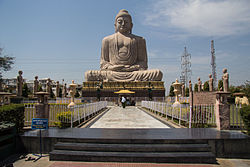
Back بود جايا Arabic بود جايا ARZ बोधगया Bihari বুদ্ধ গয়া Bengali/Bangla བྱང་ཆུབ་སྙིང་པོ་ Tibetan বোধ গয়া BPY Bodh Gaya CEB Bódhgaja Czech Bodh Gaya Welsh Bodhgaya German
Bodh Gayā | |
|---|---|
Town | |
 | |
| Coordinates: 24°41′42″N 84°59′33″E / 24.6950°N 84.9925°E | |
| Country | |
| State | Bihar |
| District | Gaya |
| Area (2015)[A 1] | |
| • City | 20.2 km2 (7.8 sq mi) |
| • Regional planning | 83.78 km2 (32.35 sq mi) |
| Population (2018) | |
| • Total | 48,184 |
| Languages | |
| • Official | Hindi |
| Time zone | UTC+5:30 (IST) |
| PIN | 824231 |
| Vehicle registration | BR-02 |
| |
Bodh Gayā is a religious site and place of pilgrimage associated with the Mahabodhi Temple complex, situated in the Gaya district in the Indian state of Bihar. It is famous for being the place where Gautama Buddha is said to have attained enlightenment (Pali: bodhi) under what became known as the Bodhi Tree.[2] Since antiquity, Bodh Gaya has remained the object of pilgrimage and veneration, for both Hindus and Buddhists.[3] In particular, archaeological finds, including sculptures, show that the site was in use by Buddhists since the Mauryan period.[4] Bodh Gaya and the nearby regions were invaded and destroyed in the 12th century CE by Muslim Turk armies, led by Delhi Sultanate's Qutb al-Din Aibak and Bakhtiyar Khilji.
For Buddhists, Bodh Gaya is the most important of the four main pilgrimage sites related to the life of Gautama Buddha,[5] the other three being Kushinagar, Lumbini, and Sarnath. In 2002, Mahabodhi Temple, located in Bodh Gaya, became a UNESCO World Heritage Site.[6]
- ^ "पत्रांक-213 : राजगीर क्षेत्रीय आयोजना क्षेत्र एवं बोधगया आयोजना क्षेत्र के सीमांकन एवं घोषणा" (PDF). Urban Development Housing Dept., Government of Bihar, Patna. 15 April 2015. Archived (PDF) from the original on 18 June 2015. Retrieved 18 June 2015.
- ^ Gopal, Madan (1991). K.S. Gautam (ed.). India through the ages. Publication Division, Ministry of Information and Broadcasting, Government of India. p. 176.
- ^ Kinnard, Jacob. "When Is The Buddha Not the Buddha? The Hindu/Buddhist Battle over Bodhgayā and Its Buddha Image". Journal of the American Academy of Religion: 817. ISSN 0002-7189.
- ^ Fogelin, Lars (2015). An Archaeological History of Indian Buddhism. Oxford University Press. p. 195. ISBN 9780199948239.
- ^ "Buddhist Pilgrimage". Asia. Archived from the original on 27 September 2018. Retrieved 14 December 2019.
- ^ "Decisions adopted by the 26th Session of the World Heritage Committee" (PDF). World Heritage Committee. p. 62. Archived (PDF) from the original on 28 February 2015. Retrieved 10 July 2006.
© MMXXIII Rich X Search. We shall prevail. All rights reserved. Rich X Search

